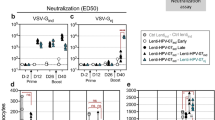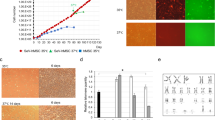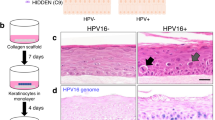Abstract
Overexpression of SV40 T-antigen (SV40 T-Ag) has been widely used to overcome replicative senescence of human primary cells and to promote cell immortalization. However, in the case of certain cell types, such as preadipocytes, the differentiation process of immortalized cells is blocked by SV40 T-Ag expression. In this study, human telomerase reverse transcriptase (hTERT) and papillomavirus E7 oncoprotein (HPV-E7) genes were coexpressed in human preadipocytes to test whether this combination could maintain cell differentiation capacity after immortalization. We demonstrated that the HPV-E7/hTERT expressing preadipocytes displayed an indefinite life span. Interestingly, immortalized cells were diploid and presented no chromosomic alterations. These immortalized cells were able to accumulate and hydrolyze intracellular triglycerides and to express adipocyte markers. These data demonstrate, for the first time, that coexpression of hTERT and HPV-E7 in human preadipocytes allows cells not only to display an indefinite life span but also to retain their capacity to differentiate.
Similar content being viewed by others
Log in or create a free account to read this content
Gain free access to this article, as well as selected content from this journal and more on nature.com
or
Abbreviations
- aP2:
-
adipocyte fatty acid binding protein
- BSA:
-
bovine serum albumin
- C/EBPα:
-
CCAAT/enhancer binding protein alpha
- Dex:
-
dexamethasone
- FBS:
-
fetal bovine serum
- GPDH:
-
glycerol-3-phosphate dehydrogenase
- hTERT:
-
human telomerase reverse transcriptase
- HPV-E7:
-
human papillomavirus E7 oncoprotein
- IBMX:
-
isobutyl methyl xanthine
- LPL:
-
lipoprotein lipase
- OA:
-
oleic acid
- PPARγ:
-
peroxisome proliferator-activated receptor gamma
- RPLp0:
-
ribosomal protein large P0
- SV40 T-Ag:
-
SV40 T-antigen
References
Jha KK, Banga S, Palejwala V and Ozer HL (1998) SV40-mediated immortalization. Exp. Cell Res. 245: 1–7
Shay JW, Wright WE and Werbin H (1991) Defining the molecular mechanisms of human cell immortalization. Biochim. Biophys. Acta. 1072: 1–7
Huschtscha LI and Holliday R (1983) Limited and unlimited growth of SV40-transformed cells from human diploid MRC-5 fibroblasts. J. Cell Sci. 63: 77–99
Halvorsen TL, Leibowitz G and Levine F (1999) Telomerase activity is sufficient to allow transformed cells to escape from crisis. Mol. Cell Biol. 19: 1864–1870
Darimont C, Avanti O, Tromvoukis Y, Vautravers-Leone P, Kurihara N, Roodman GD, Colgin LM, Tullberg-Reinert H, Pfeifer AM, Offord EA and Mace K (2002) SV40 T antigen and telomerase are required to obtain immortalized human adult bone cells without loss of the differentiated phenotype. Cell Growth Differ. 13: 59–67
Cherington V, Brown M, Paucha E, St Louis J, Spiegelman BM and Roberts TM (1988) Separation of simian virus 40 large-T-antigen-transforming and origin- binding functions from the ability to block differentiation. Mol. Cell Biol. 8: 1380–1384
Erickson RL, Hemati N, Ross SE and MacDougald OA (2001) p300 coactivates the adipogenic transcription factor CCAAT/enhancer-binding protein alpha. J. Biol. Chem. 276: 16348–16355
Lill NL, Grossman SR, Ginsberg D, DeCaprio J and Livingston DM (1997) Binding and modulation of p53 by p300/CBP coactivators. Nature 387: 823–827
Forest C, Czerucka D, Negrel R and Ailhaud G (1983) Establishment of a human cell line after transformation by a plasmid containing the early region of the SV40 genome. Cell. Biol. Int. Rep. 7: 73–81
Zwerschke W and Jansen-Durr P (2000) Cell transformation by the E7 oncoprotein of human papillomavirus type 16: interactions with nuclear and cytoplasmic target proteins. Adv. Cancer Res. 78: 1–29
Kiyono T, Foster SA, Koop JI, McDougall JK, Galloway DA and Klingelhutz AJ (1998) Both Rb/p16INK4a inactivation and telomerase activity are required to immortalize human epithelial cells. Nature 396: 84–88
Huang SM and McCance DJ (2002) Down regulation of the interleukin-8 promoter by human papillomavirus type 16 E6 and E7 through effects on CREB binding protein/p300 and P/CAF. J. Virol. 76: 8710–8721
Wabitsch M, Brenner RE, Melzner I, Braun M, Moller P, Heinze E, Debatin KM and Hauner H (2001) Characterization of a human preadipocyte cell strain with high capacity for adipose differentiation. Int. J. Obes. Relat. Metab. Disord. 25: 8–15
Zwerschke W, Mazurek S, Massimi P, Banks L, Eigenbrodt E and Jansen-Durr P (1999) Modulation of type M2 pyruvate kinase activity by the human papillomavirus type 16 E7 oncoprotein. Proc. Natl. Acad. Sci. USA 96: 1291–1296
Shrago E and Spennetta T (1976) The carbon pathway for lipogenesis in isolated adipocytes from rat, guinea pig, and human adipose tissue. Am. J. Clin. Nutr. 29: 540–545
Ray FA, Peabody DS, Cooper JL, Cram LS and Kraemer PM (1990) SV40T antigen alone drives karyotype instability that precedes neoplastic transformation of human diploid fibroblasts. J. Cell. Biochem. 42: 13–31
Liu JP (1999) Studies of the molecular mechanisms in the regulation of telomerase activity. FASEB J. 13: 2091–2104
O'Hare MJ, Bond J, Clarke C, Takeuchi Y, Atherton AJ, Berry C, Moody J, Silver AR, Davies DC, Alsop AE, Neville AM and Jat PS (2001) Conditional immortalization of freshly isolated human mammary fibroblasts and endothelial cells. Proc. Natl. Acad. Sci. USA 98: 646–651
Hickman ES, Bates S and Vousden KH (1997) Perturbation of the p53 response by human papillomavirus type 16 E7. J. Virol. 71: 3710–3718
Classon M, Kennedy BK, Mulloy R and Harlow E (2000) Opposing roles of pRB and p107 in adipocyte differentiation. Proc. Natl. Acad. Sci. USA 97: 10826–10831
Smith-McCune K, Kalman D, Robbins C, Shivakumar S, Yuschenkoff L and Bishop JM (1999) Intranuclear localization of human papillomavirus 16 E7 during transformation and preferential binding of E7 to the Rb family member p130. Proc. Natl. Acad. Sci. USA 96: 6999–7004
Roncari DA, Lau DC and Kindler S (1981) Exaggerated replication in culture of adipocyte precursors from massively obese persons. Metabolism 30: 425–427
Pfeifer AMA, Macé K, Tromvoukis Y and Lipsky MM (1995) Highly efficient establishment of immortalized cells from adult human liver. Methods Cell Science 17: 83–89
Sugihara H, Yonemitsu N, Miyabara S and Yun K (1986) Primary cultures of unilocular fat cells: characteristics of growth in vitro and changes in differentiation properties. Differentiation 31: 42–49
Bradley DC and Kaslow HR (1989) Radiometric assays for glycerol, glucose, and glycogen. Anal. Biochem. 180: 11–16
Tchkonia T, Giorgadze N, Pirtskhalava T, Tchoukalova Y, Karagiannides I, Forse RA, DePonte M, Stevenson M, Guo W, Han J, Waloga G, Lash TL, Jensen MD and Kirkland JL (2002) Fat depot origin affects adipogenesis in primary cultured and cloned human preadipocytes. Am. J. Physiol. Regul. Integr. Comp. Physiol. 282: R1286–R1296
Acknowledgements
We are grateful to Dr CC Harris (National Institutes of Health, Bethesda, USA) for the HPV-E7 recombinant retrovirus and Dr. EA Offord (Nestlé Research Center, Lausanne, Switzerland) for critically reading the manuscript.
Author information
Authors and Affiliations
Corresponding author
Rights and permissions
About this article
Cite this article
Darimont, C., Zbinden, I., Avanti, O. et al. Reconstitution of telomerase activity combined with HPV-E7 expression allow human preadipocytes to preserve their differentiation capacity after immortalization. Cell Death Differ 10, 1025–1031 (2003). https://doi.org/10.1038/sj.cdd.4401273
Received:
Revised:
Accepted:
Published:
Issue date:
DOI: https://doi.org/10.1038/sj.cdd.4401273
Keywords
This article is cited by
-
A human preadipocyte cell strain with multipotent differentiation capability as an in vitro model for adipogenesis
In Vitro Cellular & Developmental Biology - Animal (2020)
-
Differential expression of Lp-PLA2 in obesity and type 2 diabetes and the influence of lipids
Diabetologia (2018)
-
Vitamin B12 insufficiency induces cholesterol biosynthesis by limiting s-adenosylmethionine and modulating the methylation of SREBF1 and LDLR genes
Clinical Epigenetics (2015)
-
Comprehensive molecular characterization of human adipocytes reveals a transient brown phenotype
Journal of Translational Medicine (2015)
-
Immortalization of human adipose-derived stromal cells: production of cell lines with high growth rate, mesenchymal marker expression and capability to secrete high levels of angiogenic factors
Stem Cell Research & Therapy (2014)



